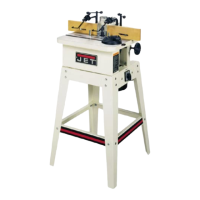OPERATION
USING
THE
FENCE
AS A
GUIDE
Shaping
with
the fence is the safest and most
satisfactory
method of working.
This
method
should
always be used when work permits.
Almost
all straight work can be used
with
the
fence.
Feed
Fig.
18
1.
For most work, where a portion of the
edge
of
the work is not touched by the cutter,
both the front and rear fences are in a
straight
line,
as shown in figure 18.
2.
When the shaping operation removes the
entire
edge
of the work (i.e. jointing or
making
a
full
bead), the shaped
edge
will
not be supported by the rear fence when
both fences are in line as shown in figure
19.
In this case, the work piece should be
advanced to the position shown in figure
19
and
stopped.
3.
The rear fence should be advanced to
contact the work as shown in figure 20.
The
rear fence
will
then be in line
with
the cutting
circle.
Feed
Fig.
19
Cutter,
Cutting
Circle
Feed
Fig.
20
SHAPING
WITH
COLLARS
AND
STARTING
PIN
Follow
these
rules when shaping
with
collars
and starling pin for safest operation and
best
results:
1.
Collars
must be smooth and free from all
gum or
other
substances.
2.
The
edge
of the work must be smooth.
Any
irregularity in the surface
which
rides
against the collar
will
be duplicated on the
shaped surface.
Not
Sufficient
Bearir^g
(—]
Surface
3.
A portion of the work's
edge
must remain
untouched by the cutter so
that
the collar
will
have sufficient bearing surface. See
figure
21 for an example of insufficient
bearing surface. Figure 22 illustrates
sufficient
bearing surface.
Collar
Cutter
n
Sufficient
Bearing
Surface
Work
Rigtit
Table
Fig.
22

